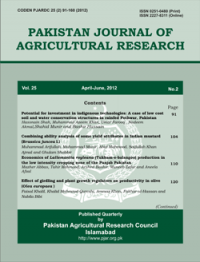ANALYTICAL DIAGNOSTICS OF NON-OPTIMAL USE OF PESTICIDES AND HEALTH HAZARDS FOR VEGETABLE PICKERS
Muneeb Zafar*, Tahir Mehmood**, Irfan Ahmad Baig**, Abdul Saboor** Mazher Abbas***, Shumaila Sadiq** and Khalid Mahmood****
ABSTRACT
Economically pesticides are meant to control pests in the fields. Up to certain optimal use of a typical pesticide, it enhances the yield of crops and vegetables. But, eventually amplified use of pesticides results in contamination of environment (water, soil, and air) and increase the health cost of vegetable pickers. The purpose of this study is to estimate the excessive use of pesticides and economic cost of health hazards for the vegetable pickers in district Vehari. Data from 90 respondents were collected and analyzed. The most common health problems identified during the survey were headache, eye irritation, skin infection, cough and shortness of breath. Health cost consists of costs related to precautionary measure, medication, traveling, the opportunity cost of attended persons and productivity loss. The mean health cost of vegetable pickers in the study area was about Rs. 385 per picker per year. Health cost model was used to measure the health cost of vegetable pickers. The regression results showed that pesticides were being applied non-optimally in the study area i.e., number of pesticide applications for vegetables (7-31) were substantially higher than the recommended dose. Health cost function was significantly different from zero as 2 indicated by F-stat (32.18) and it is also supported by R that about 70% variation in health cost is explained by medication accompanied by productivity loss (Rs. 223), precautionary measure (Rs. 134), attended person cost (Rs. 14) and traveling expenditures (Rs. 16). Hence, strict legislation is required to overcome the availability of hazardous pesticides and to keep the vegetable pickers aware of the optimal use of pesticides through appropriate extension services.
To share on other social networks, click on any share button. What are these?







